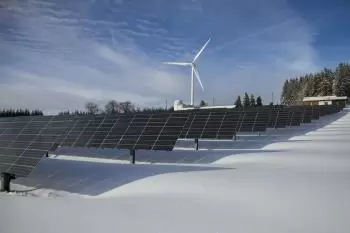
Renewable energies are sustainable and clean energy sources that are obtained from natural resources that are practically inexhaustible on a human scale and do not generate significant emissions of greenhouse gases or other pollutants harmful to the environment.
These energy sources play a critical role in mitigating climate change and reducing dependence on fossil fuels.
In this section we will explain which are the most important and fastest growing types of renewable energies worldwide and we will list some examples of uses and applications of these energies.
Examples of renewable energy
Below we show you different examples of renewable energy using different renewable sources:
Electricity generation
-
Solar panels: They are used to convert sunlight into electricity, both in residential installations and in large-scale solar plants.
-
Wind turbines: They convert the kinetic energy of the wind into electricity and are deployed in onshore and offshore wind farms.
-
Hydroelectric plants: They take advantage of the energy of water in rivers and reservoirs to generate electricity.
-
Geothermal energy: Used to produce electricity from the Earth's internal heat , commonly in geometrically active areas.
Heating and cooling
-
Solar heating systems: Use solar collectors to heat water and provide heating in homes and buildings.
-
Geothermal heat pumps : Take advantage of the constant ground temperature for efficient heating and cooling.
Transport
-
Electric Vehicles (EVs): They use electricity, generally from renewable sources, to power engines and reduce greenhouse gas emissions.
-
Biofuels: They are produced from renewable sources such as biomass crops, vegetable oils and organic waste and are used in combustion engines.
Agriculture and water
-
Solar water pumping: Used to extract water in rural or agricultural areas, using solar energy to power pumps.
-
Solar irrigation systems: They use solar energy to irrigate crops sustainably.
Rural lighting and electrification
-
Solar lamps: Provide lighting in areas without access to the electrical grid.
-
Solar microgrids: They supply electricity to isolated rural communities.
Water desalination
Solar and wind energy are used to desalinate seawater, providing drinking water in regions with a shortage of fresh water.
Types of renewable energy
The main sources of renewable energy are the following:
1. Solar energy
Solar energy is energy that directly uses solar radiation. Although the Sun does not have an inexhaustible life, it is estimated that the life of the Sun is millions of years. We distinguish two types:
-
Solar thermal energy: converts the Sun's radiation into heat energy and is used to produce hot water and steam that can be used to drive a turbine connected to an electrical generator.
-
Photovoltaic solar energy: transforms solar energy into electricity using photovoltaic panels.
2. Wind energy
The renewable resource that powers these systems is the power of the wind. Wind turbines are devices designed to convert wind energy into electricity.
The wind moves due to differences in pressure and temperature caused directly or indirectly by the Sun. The moving wind has kinetic energy that windmills convert into electricity.
There are two types of wind installations:
-
Isolated wind energy installations.
-
Wind farms, made up of a set of wind turbines, to sell the electrical energy generated to the grid.
3. Hydropower
Hydraulic energy takes advantage of the potential energy of water to obtain mechanical work. If we use this work to power a generator we obtain electricity.
Hydropower is renewable thanks to the water cycle, which is a consequence of solar energy.
The main advantage of hydraulic energy is that energy can be stored in the form of potential energy. At times of demand, this energy is released to generate electricity.
There are fundamentally two types of hydroelectric plants:
-
Run-of-river hydroelectric plants: these plants capture a part of the flow circulating through a river.
-
Hydroelectric plants at the foot of the dam: this type of plant is located downstream of the reservoirs.
4. Biomass
Biomass is based on the use of organic materials of plant or animal origin. This type of renewable energy also includes the products and by-products resulting from its transformation.
Biofuels whose main use is for transportation may also be included.
The applications of biomass can be grouped into two groups:
-
Domestic and industrial applications that work through the direct combustion of biomass.
-
Applications linked to the emergence of new resources and new transformation techniques, such as gasification and pyrolysis of biomass.
5. Tidal and wave energy
The seas and oceans are immense solar collectors from which energy can be extracted from diverse sources (waves, tides and thermal gradients).
The energy released by seawater in its rising and falling movements of the tides is used in tidal power plants. Energy is obtained by passing water through hydraulic turbines.
The conversion of ocean thermal energy allows energy to be obtained from the temperature difference between the water on the surface and that found at 100 m depth.
6. Geothermal energy
Geothermal energy is obtained from heat in the underground layers of the earth.
The amount of thermal energy stored inside the Earth is enormous. The exploitation of this energy resource has practically no effect on the internal energy of the Planet. For this reason it is considered renewable energy.
To obtain thermal energy, a heat transfer fluid is circulated through these areas. The liquid transports heat energy to the surface.
Depending on the application, the thermal energy generated is used to obtain electricity (geothermal plants) or to obtain domestic hot water and heating in a home.